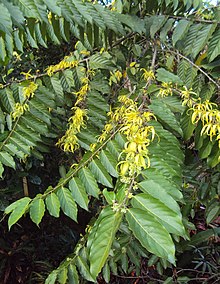| Cananga | |
|---|---|

| |
| Cananga odorata, leaves and flowers | |
| Scientific classification | |
| Kingdom: | Plantae |
| Clade: | Tracheophytes |
| Clade: | Angiosperms |
| Clade: | Magnoliids |
| Order: | Magnoliales |
| Family: | Annonaceae |
| Subfamily: | Ambavioideae |
| Genus: | Cananga (DC.) Hook.f. & Thomson, nom. cons.[1] |
Cananga (ultimately from Proto-Malayo-Polynesian *kanaŋa)[2] is a small genus of trees in the family Annonaceae, native to Indo-China and Malesia, but introduced elsewhere.[3] One of its species, Cananga odorata, is important as the source of the perfume ylang-ylang.[4]
Two species are recognized:[3][5]
Cananga latifolia is listed as a separate species in some sources,[6] but the basionym, Unona latifolia Hook.f. & Thomson, is a later homonym of Unona latifolia Dunal and so is not an acceptable name. Unona brandisiana was explicitly proposed as a replacement name.[5]